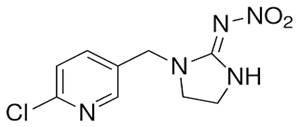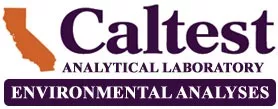Imidacloprid Analysis
Imidacloprid is the most prominent pesticide belonging to a class of insecticides called neonicotinoids and is monitored by the Coalitions in the Central Valley Water Board's Irrigated Lands Regulatory Program (ILRP). First approved by the EPA in 1994, Imidacloprid has become one of the most widely used insecticides in the world, common in agriculture, home protection, and gardening. Recent years have seen an increased push in neonicotinoid regulations as studies have demonstrated acute toxicity to pollinators, most notably the honeybee. The European Union has placed a full outdoor ban on several neonicotinoids, including Imidacloprid, and the EPA is expected to release new regulations regarding their use by the end of 2022.
Imidacloprid irreversibly binds to receptors within the central nervous system of insects. This creates a blockage at the receptor site preventing neurotransmitters from sending impulses across the neural synapse, permanently paralyzing the insect. Due to the potency of Imidacloprid on target pest populations, it can be applied at much lower concentrations than comparable insecticides. Increased sensitivity at the analytical level is necessary to capture the reduced concentrations of Imidacloprid present in water runoff.
While Imidacloprid breaks down rapidly in water when exposed to light, it is incredibly stable in the absence of light. This characteristic, combined with a low volatility, means Imidacloprid can survive months after application in groundwater and years in soil. The pesticide is highly water soluble which increases the likelihood of leaching into local groundwater for extended periods of time. A 2012 monitoring study run by the California Department of Pesticide Regulation found detectable levels of Imidacloprid in 89% of the surface water samples collected from three disparate agricultural regions in California. Of these, 100% exceeded the EPA's chronic invertebrate Aquatic Life Benchmark of 0.01 µg/L. 63% of detectable samples exceeded the EPA's acute invertebrate Aquatic Life Benchmark of 0.385 µg/L.
In response to the Central Valley Water Board's request for analytical methods that can achieve the desired Minimum Reporting Level (MRL) of 0.01 µg/L for imidacloprid in whole water (unfiltered) samples from surface waters and wastewater effluent, Caltest has developed, validated and acquired CA-ELAP accreditation for analysis of this compound.
Samples are collected in 1-liter amber glass bottles to protect them from photodegradation. These samples are extracted using a modified EPA-632 method and brought to a 1 milliliter final volume. All analyses are accompanied with a Method Blank, Laboratory Control Sample (LCS), and Matrix Spike and Matrix Spike Duplicate (MS and MSD). It is important in collection of samples to provide two additional 1-liter bottles for the Matrix Spike and Spike duplicates, (total of three liters required, four if an extra volume is provided in case of the need for sample re-extraction).
Caltest Analytical Laboratory achieves detection limits below the 0.01 µg/L benchmark through the use of reversed-phase high pressure liquid chromatography (HPLC). Our extraction and analytical methods have been uniquely tuned to take advantage of the low volatility and high solubility of Imidacloprid. The analytical system is calibrated from 0.002 µg/L to 0.500 µg/L with a reporting limit of 0.005 µg/L. System check standards are run every ten samples and at the end of each run to ensure system sensitivity has maintained acceptability. Potential matches in client samples are verified through second method confirmation via UV-VIS spectral imaging.

For more information or a quote for Imidacloprid analyses, please email us at info@caltestlabs.com.
|
||||
| Analyte | RL | MDL* | Units | |
| Imidacloprid | 0.005 | 0.004 | μg/L | |
*MDL values listed on the website may not be reflective of the most current MDL study. Check with the lab for the most current list.
References
"Aquatic Life Benchmarks and Ecological Risk Assessments for Registered Pesticides | US EPA." US EPA, 13 Apr. 2015, https://www.epa.gov/pesticide-science-and-assessing-pesticide-risks/aquatic-life-benchmarks-and-ecological-risk.
In-text Citation:("Aquatic Life Benchmarks and Ecological Risk Assessments for Registered Pesticides | US EPA")
"Conclusion on the Peer Review of the Pesticide Risk Assessment for Bees for the Active Substance Clothianidin." EFSA Journal, no. 1, Wiley, Jan. 2013, p. 3066. Crossref, doi:10.2903/j.efsa.2013.3066.
Koshlukova, Svetlana, and Nu-may Reed. "Imidacloprid: Risk Characterization Document." Cdpr.ca.Gov, Department of Pesticide Regulation, 9 Feb. 2006, https://www.cdpr.ca.gov/docs/risk/rcd/imidacloprid.pdf.
"Method 632: The Determination of Carbamate and Urea Pesticides in Municipal and Industrial Wastewater ." EPA, 1992.
"Neonicotinoids." Food Safety, https://ec.europa.eu/food/plants/pesticides/approval-active-substances/renewal-approval/neonicotinoids_en.
Starner, Keith, and Kean S. Goh. "Detections of the Neonicotinoid Insecticide Imidacloprid in Surface Waters of Three Agricultural Regions of California, USA, 2010–2011." Bulletin of Environmental Contamination and Toxicology, no. 3, Springer Science and Business Media LLC, Jan. 2012, pp. 316–21. Crossref, doi:10.1007/s00128-011-0515-5.
